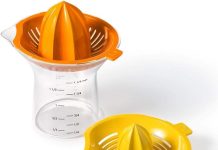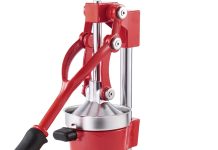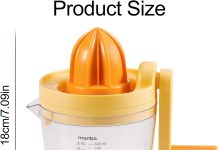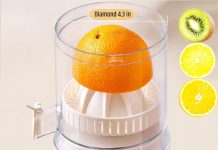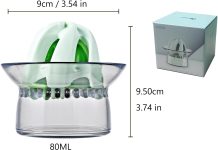If you’ve ever stood in front of a kitchen appliance aisle, scratching your head and wondering what sets a juicer apart from a blender, we’ve got you covered. Both these countertop machines are designed to help you make delicious and nutritious drinks, but they do have some key differences that can greatly impact your beverage options. Let’s take a closer look at the juicer and the blender to demystify their unique functions and find out which one might be the perfect fit for your kitchen.
Review contents
Function
Juicer
A juicer is a kitchen appliance specifically designed to extract juice from fruits and vegetables. Its main purpose is to separate the liquid content from the solid pulp, leaving behind a smooth and concentrated juice. This means that a juicer is a perfect choice when you want a refreshing and healthy drink without any fibrous or chunky bits.
Blender
On the other hand, a blender is a versatile kitchen appliance that can be used for a variety of functions such as blending, pureeing, and mixing. While a juicer is primarily focused on extracting juice, a blender is designed to blend all the ingredients together, including the pulp and fiber, resulting in a thick and smooth drink or mixture.
Mechanism
Juicer
The mechanism of a juicer involves a powerful motor that spins at high speeds, grinding the fruits and vegetables into a pulp and extracting the juice through a sieve or filter. There are two main types of juicers: centrifugal juicers and masticating juicers.
Centrifugal juicers work by using a rapidly spinning blade to separate the juice from the pulp through centrifugal force. They are generally faster and more affordable, but may not be as effective in extracting juice from leafy greens or fibrous fruits.
Masticating juicers, also known as cold-pressed or slow juicers, use a slower crushing and squeezing action to extract the juice. This method helps preserve more nutrients and enzymes in the juice, making it a popular choice among health-conscious individuals.
Blender
Blenders, on the other hand, operate by using a powerful motor to rotate sharp blades at high speeds. These blades break down the ingredients into a smooth consistency, ensuring a creamy and well-blended drink. Some blenders also come with different speed settings and pre-programmed functions, allowing you to customize your blending experience.
Extraction Method
Juicer
The extraction method of a juicer focuses on separating the liquid juice from the solid pulp. By grinding the fruits and vegetables into a fine pulp and then straining it, juicers are able to extract only the liquid content. This results in a pure and concentrated juice, free from any fibrous or chunky particles.
Blender
In contrast, blenders do not separate the juice from the solid ingredients. Instead, they break down the ingredients into a homogeneous mixture, resulting in a thicker and more textured drink. Blending retains the fiber and pulp, making it a great option for those looking to increase their daily fiber intake.
Fiber Content
Juicer
While a juicer efficiently removes the pulp and fiber from the juice, this also means that the final product may contain less fiber compared to using a blender. However, the absence of fiber in the juice can be advantageous for individuals with digestive issues or those who prefer a smoother and more easily digestible drink.
Blender
Blenders retain the fiber content of the fruits and vegetables, resulting in a drink that is thicker and more filling. This makes it an ideal choice for those looking to incorporate more fiber into their diet, aiding in digestion and promoting a feeling of fullness. Blended drinks can also help regulate blood sugar levels and promote healthy bowel movements.
Consistency of Output
Juicer
Due to the extraction method of separating the juice from the pulp, juicers produce a smoother and more liquid-like consistency. The pulp is left behind, resulting in a pure juice with minimal texture. This consistency is perfect for those who prefer a refreshing and easily drinkable juice.
Blender
Blenders, on the other hand, produce a thicker and more textured consistency. The inclusion of the fiber and pulp in the mixture gives it a smoothie-like texture, which some individuals find more enjoyable and satiating. The end result can be customized depending on the blending time, with shorter bursts resulting in a chunkier texture and longer blending achieving a smoother consistency.
Nutrient Retention
Juicer
One advantage of using a juicer is the potential for higher nutrient retention. Cold-pressed or slow juicers, in particular, utilize a method that minimizes heat and oxidation, helping to preserve the natural enzymes, vitamins, and minerals present in the fruits and vegetables. These nutrients are readily absorbed by the body, providing a concentrated dose of goodness in each glass of juice.
Blender
While blenders also retain a significant amount of nutrients, the blending process may generate heat due to the high-speed rotating blades. This heat can slightly affect the nutrient content of the ingredients. Nonetheless, blending still allows for the retention of a wide range of essential nutrients, making it a healthy choice for those seeking a nutritious drink.
Versatility
Juicer
When it comes to versatility, juicers have a more limited scope of use compared to blenders. Their primary function is to extract juice, so they are best suited for making fresh fruit and vegetable juices. Juicers may struggle with processing leafy greens or certain types of produce that have a low water content.
Blender
Blenders, on the other hand, are incredibly versatile. Not only can they make smoothies and protein shakes, but they can also be used for making soups, sauces, dips, and even grinding nuts or coffee beans. The ability to blend a wide variety of ingredients makes blenders a valuable tool in any kitchen.
Ease of Use
Juicer
Juicers are generally easy to use, although some models may require a bit of assembly or disassembly before and after use. Most juicers have a feeding chute where you place the fruits and vegetables, and the machine takes care of the rest. However, juicers with smaller feeding chutes may require you to chop the produce into smaller pieces beforehand.
Blender
Blenders are also quite easy to use. Simply place the ingredients into the blending jar, secure the lid, and select the desired speed or program. Some blenders even have pre-programmed functions for specific purposes, such as making smoothies or crushing ice. The simplicity of operation makes blenders accessible to users of all skill levels.
Cleaning
Juicer
Cleaning a juicer can be more time-consuming compared to cleaning a blender. Since juicers have additional parts such as a pulp collector, a filter, and a feeding chute, there are more components that need to be washed. However, many models come with dishwasher-safe parts, making the cleaning process more convenient.
Blender
Blenders are generally easier to clean since they have fewer parts. The blending jar and lid can usually be detached and cleaned with soap and water. Some blenders are also dishwasher-safe, allowing for quick and effortless cleaning. However, caution should be exercised when handling the sharp blades to avoid any accidents.
Recommended Uses
Juicer
Juicers are recommended for individuals who prioritize drinking juice and want a more refined and concentrated form of nutrition. They are especially suitable for those with digestive issues or anyone looking to increase their intake of vitamins and minerals. Juicing can also be a popular choice for detoxification or as a quick and convenient way to consume a variety of fruits and vegetables.
Blender
Blenders are a great choice for those who seek versatility and enjoy the inclusion of fiber and pulp in their drinks. They are ideal for making smoothies, protein shakes, and even creamy soups. Blenders are also a popular choice for individuals who prefer a more filling and substantial drink, as it retains the fiber content of the ingredients, aiding in digestion and promoting overall gut health. Additionally, blenders can be used for a wide range of culinary purposes, making them a valuable addition to any kitchen.
In conclusion, while both juicers and blenders serve their unique purposes in the kitchen, they differ in terms of function, mechanism, extraction method, fiber content, consistency of output, nutrient retention, versatility, ease of use, cleaning, and recommended uses. Understanding the differences between these two appliances allows you to make an informed decision based on your personal preferences and dietary goals. Whether you’re looking for a refreshing and concentrated juice or a fiber-rich smoothie, both juicers and blenders offer their own benefits and can enhance your overall health and well-being.



